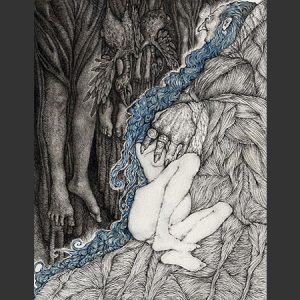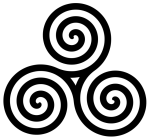Bluebeard ~ A Killer to reckon with: How to Survive the Soul’s Predator | September 18, 2010
If you think the human psyche is home to nothing but goodness and beauty, then please step aside. Because if you continue reading, you might get upset. For we shall dive into a reality that is hard to grasp by nature. It is elusive, slippery, and does not want to be seen. It feels counter-intuitive and anti-life. It is indeed both.There is an innate predator and killer in psyche. A psychic force that cannot be “rehabilitated”. A psychic force that does not transform. The challenge with all archetypal energies is to learn how to relate to them without being overtaken. For the feminine psyche, which always wants to connect and relate, this anti-life force is probably the most difficult one to come to terms with. It is too much for an individual psyche to digest.

This is the realm of Freud’s Thanatos and Jung’s dark side of the Self. These are the closest psychological images for psyche’s experience of something “evil”. Like all creatures, the human creature must also learn that there are predators, out there and within us.
The mythical imagination has always produced images and stories of this psychic reality.The tale of Bluebeard is one of them.
 Fairy
tales are simple and pure expressions of the collective unconscious and
offer a clear understanding of universal patterns in the human psyche.
The Bluebeard story in short goes as follows ~ Three sisters were
courted by a noble man who had an unusual blue beard. Two of them were
frightened of this blue beard, but the third one fell for his charm and
married him. She may do whatever she wants in his absence, open every
door in his huge castle, except one. But curiosity wins out. Encouraged
by her sisters, she opens the forbidden door and sees the blood and
dismembered corpses of Bluebeard’s previous wives. She understands what
is in store for her. Once Bluebeard found out that she has seen the
hidden chamber, he comes after her. “Please, allow me to compose myself
and prepare for my death” she pleads and was granted a quarter of an
hour. She has no intention of going quietly into her slaughter. She
posts her sisters on the castle ramparts and shouts “Sisters, sisters,
do you see our brothers coming?” And the brothers do show up, just in
the nick of time, and kill Bluebeard “leaving for the buzzards his blood
and gristle”.
Fairy
tales are simple and pure expressions of the collective unconscious and
offer a clear understanding of universal patterns in the human psyche.
The Bluebeard story in short goes as follows ~ Three sisters were
courted by a noble man who had an unusual blue beard. Two of them were
frightened of this blue beard, but the third one fell for his charm and
married him. She may do whatever she wants in his absence, open every
door in his huge castle, except one. But curiosity wins out. Encouraged
by her sisters, she opens the forbidden door and sees the blood and
dismembered corpses of Bluebeard’s previous wives. She understands what
is in store for her. Once Bluebeard found out that she has seen the
hidden chamber, he comes after her. “Please, allow me to compose myself
and prepare for my death” she pleads and was granted a quarter of an
hour. She has no intention of going quietly into her slaughter. She
posts her sisters on the castle ramparts and shouts “Sisters, sisters,
do you see our brothers coming?” And the brothers do show up, just in
the nick of time, and kill Bluebeard “leaving for the buzzards his blood
and gristle”.Just like a dream, a fairytale is not to be taken literally. It depicts the dance and the dynamics between the two grand archetypal forces, the masculine and the feminine, as they manifest in the collective as well as in the individual psyche. Both, dreams and fairy tales can be a kind of roadmap to discern an attitude that will allow, in fairy tale terms, for the princess to get her prince, and in Jungian language, for the union of opposites and the sacred marriage of the masculine and the feminine within ones soul.
Bluebeard is well and alive in the outer manifest world. In his densest form, a person, usually but not always, a male, becomes identified with Bluebeard’s energy and is then encountered, in the serial killer (yes, they do exist), the rapist, the human trafficker. Many of his victims won’t live to tell the story.
Even more prevalent is the sadistic, wife-beating husband. But Bluebeard also manifests through the man who is emotionally abusive. There is a violence that can be inflicted on a woman’s (AND the perpetrator’s) soul, which draws blood not from the physical but from the subtle body. This injury can be even more devastating than its physical counterpart. Sadly, it is ignored or played down by society.

The emotionally abusive man is often a pathological narcissist, unwilling/unable to genuinely feel for anyone (including his own feeling self), although he can be sentimental and whiny when it comes to his own needs. Because he is disconnected from a nourishing center in psyche, he always needs to put himself, his ego, into the center of his own lonely universe. His alienation from the source forces the pathological narcissist to more and more drastic measures. He violently seeks to pierce through to a reality that will finally support him. That often leaves a trail of blood and corpses, sometimes symbolically, sometimes unfortunately literally. Horrifying in both instances.
But our naive heroine, who fell for the deadly charmer, survives and Bluebeard is dismembered and dead. But if a fairy tale is a map, what do we learn about the right kind of attitude to escape Bluebeard? A few things stand out for me. Naive the young woman may be, but not submissive and obedient. She wants to know. Only her disobedience allows her to survive. She becomes a warrioress for life
 and lies to the lier. Like is cured by like. When she opened the door to the torture chamber, she truly sees.
She does not escape into fantasies, as so many women in abusive
relationships do, “It won’t happen to me, he really loves me, he will
change”… and so on. Nor is she plagued by feelings of paralyzing shame
for having been so terribly betrayed, (an irrational, but all-to-common
response to abuse). When she sees, she knows, there is no more turning
back.
and lies to the lier. Like is cured by like. When she opened the door to the torture chamber, she truly sees.
She does not escape into fantasies, as so many women in abusive
relationships do, “It won’t happen to me, he really loves me, he will
change”… and so on. Nor is she plagued by feelings of paralyzing shame
for having been so terribly betrayed, (an irrational, but all-to-common
response to abuse). When she sees, she knows, there is no more turning
back.Her willingness and strength to face the truth is activating positive masculine energies in her, which manifest in her ability to sever the ties of Bluebeard’s seductive charm. Bluebeard’s power is fading. His dismemberment has begun. Her own inner masculinity is gaining muscle, which the fairytale depicts in the sudden appearance of brothers who put an end to Bluebeard. As an archetypal force he will not disappear, but in the life of this woman Bluebeard has no more hold over her.

For those interested in the psychological and mythological meaning of fairy-tales, I would like to point to the work of Marie-Luise von Franz, one of the most brilliant first generation Jungian Analysts who was a close collaborator with C.G.Jung himself. I particularly recommend “The Interpretation of Fairy Tales” and “Shadow and Evil in Fairy Tales”
The French director Catherine Breillart created a film version of “Bluebeard” in 2009, exploring the dark erotic bond characteristic of this particular dynamic, which might be of further interest.
https://jungianwork.wordpress.com/
No comments:
Post a Comment